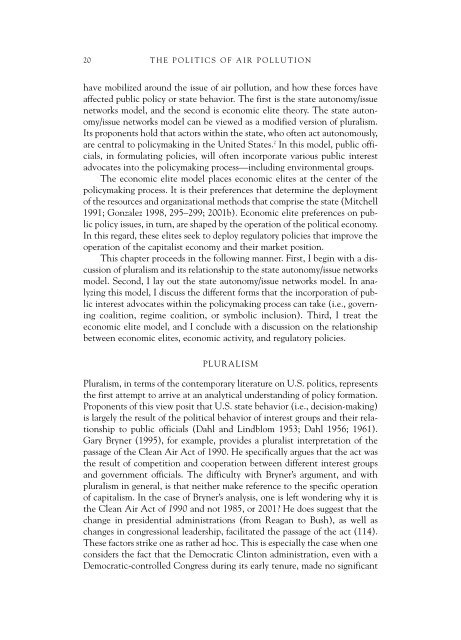GEORGE A. GONZALEZ - fieldi
GEORGE A. GONZALEZ - fieldi
GEORGE A. GONZALEZ - fieldi
Create successful ePaper yourself
Turn your PDF publications into a flip-book with our unique Google optimized e-Paper software.
20THE POLITICS OF AIR POLLUTIONhave mobilized around the issue of air pollution, and how these forces haveaffected public policy or state behavior. The first is the state autonomy/issuenetworks model, and the second is economic elite theory. The state autonomy/issuenetworks model can be viewed as a modified version of pluralism.Its proponents hold that actors within the state, who often act autonomously,are central to policymaking in the United States. 2 In this model, public officials,in formulating policies, will often incorporate various public interestadvocates into the policymaking process—including environmental groups.The economic elite model places economic elites at the center of thepolicymaking process. It is their preferences that determine the deploymentof the resources and organizational methods that comprise the state (Mitchell1991; Gonzalez 1998, 295–299; 2001b). Economic elite preferences on publicpolicy issues, in turn, are shaped by the operation of the political economy.In this regard, these elites seek to deploy regulatory policies that improve theoperation of the capitalist economy and their market position.This chapter proceeds in the following manner. First, I begin with a discussionof pluralism and its relationship to the state autonomy/issue networksmodel. Second, I lay out the state autonomy/issue networks model. In analyzingthis model, I discuss the different forms that the incorporation of publicinterest advocates within the policymaking process can take (i.e., governingcoalition, regime coalition, or symbolic inclusion). Third, I treat theeconomic elite model, and I conclude with a discussion on the relationshipbetween economic elites, economic activity, and regulatory policies.PLURALISMPluralism, in terms of the contemporary literature on U.S. politics, representsthe first attempt to arrive at an analytical understanding of policy formation.Proponents of this view posit that U.S. state behavior (i.e., decision-making)is largely the result of the political behavior of interest groups and their relationshipto public officials (Dahl and Lindblom 1953; Dahl 1956; 1961).Gary Bryner (1995), for example, provides a pluralist interpretation of thepassage of the Clean Air Act of 1990. He specifically argues that the act wasthe result of competition and cooperation between different interest groupsand government officials. The difficulty with Bryner’s argument, and withpluralism in general, is that neither make reference to the specific operationof capitalism. In the case of Bryner’s analysis, one is left wondering why it isthe Clean Air Act of 1990 and not 1985, or 2001? He does suggest that thechange in presidential administrations (from Reagan to Bush), as well aschanges in congressional leadership, facilitated the passage of the act (114).These factors strike one as rather ad hoc. This is especially the case when oneconsiders the fact that the Democratic Clinton administration, even with aDemocratic-controlled Congress during its early tenure, made no significant









